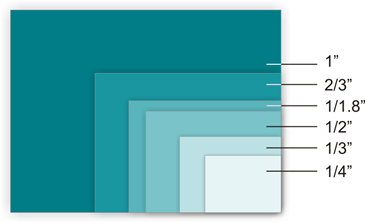
IDS peak 2.17.1 / uEye+ firmware 3.70
IDS Peak comfortSDK, genericSDK, IPL, and AFL developer manuals are external documents. Please contact us if you need them.

Fig. 1: Common sensor sizes (in inch)
The size of image sensors is typically given in inches. This is a nominal size that does not directly refer to the physical size of the sensor. When image sensors are concerned, one inch equals 16 millimeters (instead of 25.4 mm). This conversion dates back to tube technology: With a 1" tube (outer diameter = 25.4 mm), the light sensitive area had a diagonal of approximately 16 mm. Using this nominal size, referring to the outer diagonal of the tube instead of the light sensitive area, was continued even with the introduction of semiconductor sensor technology.
The following figure illustrates the most common sensor formats (in inches) and their corresponding diagonals (in millimeters).

Fig. 2: Common sensor formats and their diagonal dimensions
The nominal sensor size (in inches) is just a rough estimate of the light sensitive diagonal. The true dimensions can be calculated from the sensor's resolution (width and height) multiplied with its pixel size. Example: A sensor with 1456 x 1088 px resolution and a pixel size of 3.45 µm has an optical area of 5.023 mm x 3.754 mm and a diagonal of approx. 6.27 mm. Its nominal size is 1/3''.
What else should you know about sensor size?
•Using the same lens, the field of view (FOV) decreases for smaller sensors. Changing to a sensor with a different size also requires a different lens (different focal length), if the FOV should be kept.

Fig. 3: Comparison of common sensor sizes and their fields of view
•The sensor and lens must be matched both in size and in the achievable resolution in order to get high image quality. You can use the IDS lens finder to find a lens that matches your camera model.
•Larger sensors often have larger pixels, can receive more light and therefore have a better signal-to-noise ratio and higher image quality.
•Smaller sensors are usually less expensive.